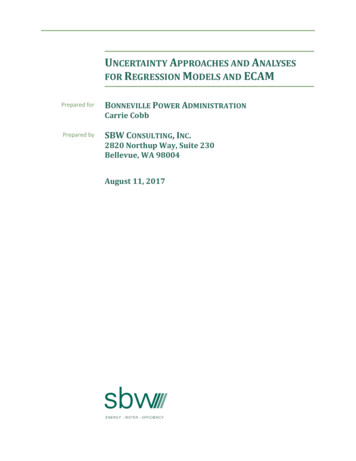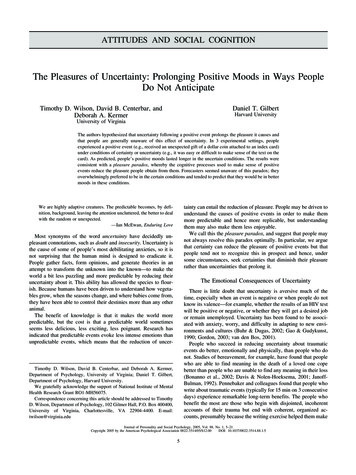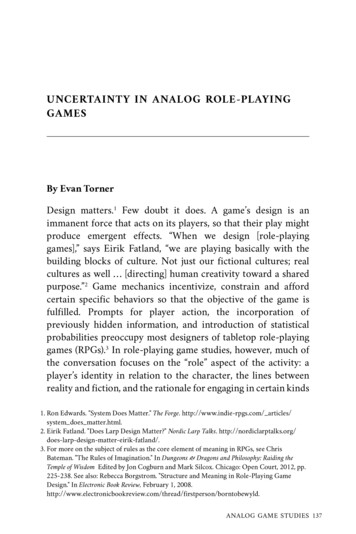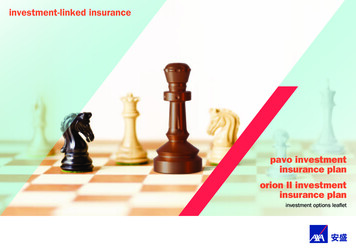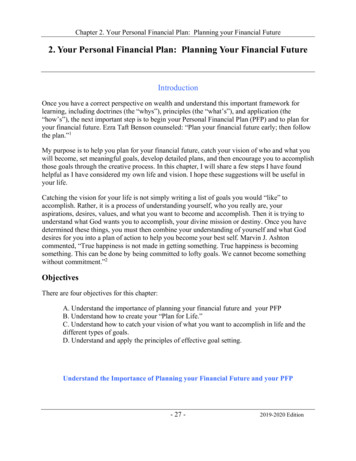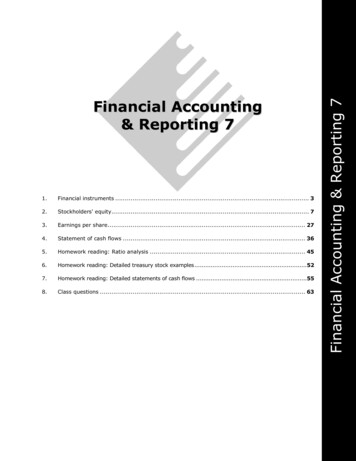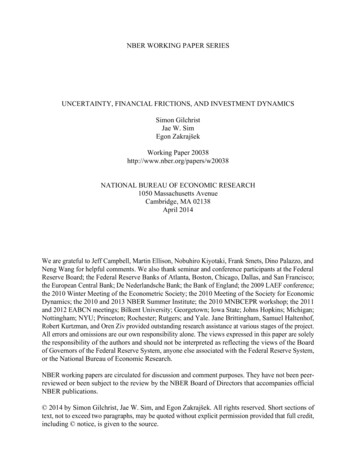
Transcription
NBER WORKING PAPER SERIESUNCERTAINTY, FINANCIAL FRICTIONS, AND INVESTMENT DYNAMICSSimon GilchristJae W. SimEgon ZakrajšekWorking Paper 20038http://www.nber.org/papers/w20038NATIONAL BUREAU OF ECONOMIC RESEARCH1050 Massachusetts AvenueCambridge, MA 02138April 2014We are grateful to Jeff Campbell, Martin Ellison, Nobuhiro Kiyotaki, Frank Smets, Dino Palazzo, andNeng Wang for helpful comments. We also thank seminar and conference participants at the FederalReserve Board; the Federal Reserve Banks of Atlanta, Boston, Chicago, Dallas, and San Francisco;the European Central Bank; De Nederlandsche Bank; the Bank of England; the 2009 LAEF conference;the 2010 Winter Meeting of the Econometric Society; the 2010 Meeting of the Society for EconomicDynamics; the 2010 and 2013 NBER Summer Institute; the 2010 MNBCEPR workshop; the 2011and 2012 EABCN meetings; Bilkent University; Georgetown; Iowa State; Johns Hopkins; Michigan;Nottingham; NYU; Princeton; Rochester; Rutgers; and Yale. Jane Brittingham, Samuel Haltenhof,Robert Kurtzman, and Oren Ziv provided outstanding research assistance at various stages of the project.All errors and omissions are our own responsibility alone. The views expressed in this paper are solelythe responsibility of the authors and should not be interpreted as reflecting the views of the Boardof Governors of the Federal Reserve System, anyone else associated with the Federal Reserve System,or the National Bureau of Economic Research.NBER working papers are circulated for discussion and comment purposes. They have not been peerreviewed or been subject to the review by the NBER Board of Directors that accompanies officialNBER publications. 2014 by Simon Gilchrist, Jae W. Sim, and Egon Zakrajšek. All rights reserved. Short sections oftext, not to exceed two paragraphs, may be quoted without explicit permission provided that full credit,including notice, is given to the source.
Uncertainty, Financial Frictions, and Investment DynamicsSimon Gilchrist, Jae W. Sim, and Egon ZakrajšekNBER Working Paper No. 20038April 2014JEL No. E22,E32,G31ABSTRACTMicro- and macro-level evidence indicates that fluctuations in idiosyncratic uncertainty have a largeeffect on investment; the impact of uncertainty on investment occurs primarily through changes incredit spreads; and innovations in credit spreads have a strong effect on investment, irrespective ofthe level of uncertainty. These findings raise a question regarding the economic significance of thetraditional “wait-and-see” effect of uncertainty shocks and point to financial distortions as the mainmechanism through which fluctuations in uncertainty affect macroeconomic outcomes. The relativeimportance of these two mechanisms is analyzed within a quantitative general equilibrium model,featuring heterogeneous firms that face time-varying idiosyncratic uncertainty, irreversibility, nonconvexcapital adjustment costs, and financial frictions. The model successfully replicates the stylized factsconcerning the macroeconomic implications of uncertainty and financial shocks. By influencing theeffective supply of credit, both types of shocks exert a powerful effect on investment and generatecountercyclical credit spreads and procyclical leverage, dynamics consistent with the data and counterto those implied by the technology-driven real business cycle models.Simon GilchristDepartment of EconomicsBoston University270 Bay State RoadBoston, MA 02215and NBERsgilchri@bu.eduJae W. SimDivision of Research & StatisticsFederal Reserve Board20th Street & Constitution Avenue, NWWashington, D.C. 20551jae.w.sim@frb.govEgon ZakrajšekDivision of Monetary AffairsFederal Reserve Board20th Street & Constitution Avenue, NWWashington, D.C. 20551egon.zakrajsek@frb.gov
1IntroductionMacroeconomists have made a convincing argument that the well-documented countercyclical behavior of the cross-sectional dispersion of economic variables such as labor income, business profits, productivity, and stock returns reflects fluctuations in the volatility of the underlying economic shocks—that is, swings in economic uncertainty.1 How such uncertainty fluctuations influence business cycle dynamics has traditionally been analyzed within the framework of irreversible investment (see Bernanke, 1983; Bertola and Caballero, 1994; Abel and Eberly, 1994, 1996;Caballero and Pindyck, 1996; Bloom, 2009; Bloom et al., 2011; Bachmann and Bayer, 2009, 2013).This approach to corporate resource allocation treats the firm’s future investment opportunities as“real options” and emphasizes the importance of waiting and staging flexibility when making investment decisions—in response to increased uncertainty, firms should wait and see until uncertaintyis resolved and the project is more clearly successful.2Spurred by the surge in asset price volatility and the blowout in credit spreads during the2007–09 financial crisis, an emergent literature has pointed to financial market frictions as anadditional channel through which volatility fluctuations can affect macroeconomic outcomes (seeArellano et al., 2012; Christiano et al., 2014). According to the canonical framework used to pricerisky debt, the return on levered equity resembles—under limited liability—the payoff of a calloption, whereas the bondholders face the payoff structure that mimics that of an investor writinga put option. An increase in the riskiness of the firm’s assets thus benefits equity holders at theexpense of bondholders, implying a rise in credit spreads to compensate bondholders for heighteneduncertainty. To the extent that external finance—both through the debt and equity markets—issubject to agency and/or moral hazard problems, an increase in uncertainty will raise the user costof capital, inducing a decline in investment spending.Given these two complementary channels of how changes in uncertainty can affect the realeconomy, this paper seeks to answer the following question: How much of the impact of fluctuations in uncertainty on aggregate investment reflects capital adjustment frictions associatedwith irreversibility—the traditional wait-and-see effect—and how much of it can be attributed todistortions in financial markets? We answer this question by developing a quantitative businesscycle model that allows us to analyze the effect of fluctuations in uncertainty on investment dynamics in a general equilibrium setting featuring partial irreversibility and frictions in both thedebt and equity markets. Specifically, we formulate a capital accumulation problem, in which het1See Campbell and Taksler (2003), Storesletten et al. (2004), Eisfeldt and Rampini (2006), Bloom (2009), andBloom et al. (2011) for arguments and evidence. It is worth emphasizing, however, that there is no objective measureof time-varying economic uncertainty. In addition to the uncertainty proxies noted above, this burgeoning literature has employed indexes based on the frequency of “uncertainty-related” words or phrases that occur across alarge number of news sources (Baker et al., 2013), the cross-sectional dispersion of survey-based business forecasts(Bachmann et al., 2013b), and the common variation in the unforecastable component of a large number of economicindicators (Jurado et al., 2013) to infer fluctuations in uncertainty.2Despite its intuitive appeal, the effect of uncertainty on investment in the presence of irreversibilities can betheoretically ambiguous. As shown, for example, by Abel (1983) and Veracierto (2002), the effect depends importantlyon the assumptions regarding the initial accumulation of capital, market structure, and the equilibrium setting.1
erogeneous firms employ a decreasing returns-to-scale production technology that is subject to apersistent idiosyncratic shock, the variance of which is allowed to vary over time according to astochastic law of motion. The capital accumulation problem is subject to partial irreversibilityand fixed adjustment costs, two forms of adjustment frictions emphasized in the influential work ofAbel and Eberly (1994, 1996), Caballero et al. (1995), Doms and Dunne (1998), Caballero (1999),Cooper et al. (1999), Cooper and Haltiwanger (2006), and Bachmann et al. (2013a).On the financial side, firms make investment decisions subject to a full range of choices regarding their capital structure—internal funds, debt, and equity financing—in an environment whereexternal funds are costly because of agency problems in financial markets. The partial investmentirreversibility plays two roles in our model. First, it creates the option value of waiting. In response to increased uncertainty, the investment inaction region expands, which causes some firmsto delay exercising their growth options—that is, they adopt a wait-and-see posture. Second, thegreater downside risk limits the firms’ debt capacity because heightened uncertainty—under limited liability—favors the firm’s shareholders over its bondholders, thereby inducing a decline inthe market value of debt claims. Thus, the model provides a unified quantitative framework foranalyzing the implications of the interaction between the capital and debt overhang problems forbusiness cycle dynamics.3Our analysis of the interaction between uncertainty and financial conditions is informed importantly by new empirical evidence that highlights the strong relationship between uncertainty,investment, and credit spreads on corporate bonds, a commonly used indicator of the degree of financial market frictions.4 Specifically, we construct a new proxy for idiosyncratic uncertainty usinghigh-frequency firm-level stock market data, a measure that arguably reflects exogenous changesin uncertainty, rather than the endogenous effects of informational and contractual frictions thathave been theoretically linked to the countercyclical dispersion in economic returns. For a subsetof large corporations, we match this estimate of uncertainty to the firms’ income and balance sheetstatements and, most importantly, to prices of their individual corporate bonds trading in thesecondary market.Using this novel micro-level data set, we find that conditional on the firm’s leverage, profitability, and other indicators of creditworthiness, idiosyncratic volatility is an important determinant of credit spreads on the firm’s outstanding bonds. We also show that conditional on investment fundamentals—that is, proxies for the marginal product of capital—increases in idiosyncraticvolatility are associated with a substantial decline in the rate of capital formation. However, oncethe information content of credit spreads is taken into account, the impact of uncertainty on business3Earlier theoretical explorations of this interaction can be found in Shleifer and Vishny (1992), Eisfeldt (2004),and Manso (2008).4The fact that the level of credit spreads provides a useful metric for gauging the tightness of financial conditionsin the economy and thus the implied degree of departure from the Modigliani–Miller paradigm of frictionless financialmarkets is supported by considerable empirical evidence showing that corporate bond credit spreads form the mostinformative and reliable class of financial indicators for future economic activity and that shocks to credit spreadslead to adverse macroeconomic outcomes (see Gertler and Lown, 1999; Gilchrist et al., 2009; Gilchrist and Zakrajšek,2012; Faust et al., 2013).2
investment is significantly attenuated. Capital expenditures, by contrast, remain highly responsiveto movements in credit spreads.To gauge the macroeconomic implications of these findings, we use a structural vector autoregression (SVAR) framework to examine the interaction between uncertainty, credit spreads, andeconomic activity. The results from this macro-level analysis confirm our finding that credit spreadsare an important conduit through which fluctuations in volatility are propagated to the real economy. By inducing a significant widening of credit spreads, unanticipated increases in uncertaintylead to a decline in real GDP that is driven primarily by the protracted drop in the investmentcomponent of aggregate spending. In contrast, financial disturbances—identified vis-à-vis orthogonalized shocks to credit spreads—have a large effect on economic activity, irrespective of the levelof uncertainty. The combination of the micro- and macro-level results is thus consistent with thenotion that financial frictions are an important part of the mechanism through which uncertaintyshocks affect the economy.Simulations of our general equilibrium model accord well with the empirical results. By alteringthe effective supply of credit, financial distortions significantly amplify the response of businessinvestment to volatility shocks. Although the risk-free rate falls in response to increased uncertainty,this easing of financial conditions is more than offset by the sharp and persistent increase in creditspreads. The resulting increase in the user cost of capital leads firms to slash capital outlaysand delever, creating a quantitatively important channel through which fluctuations in uncertaintyshape business cycle dynamics. In an economy without financial distortions, by contrast, this usercost of capital channel is significantly attenuated, and the response of investment to uncertaintyshocks is an amalgam of the wait-and-see decisions of individual firms.These findings are consistent with those of Christiano et al. (2014), who analyze the macroeconomic implications of volatility shocks in the context of a financial accelerator model adapted fromBernanke et al. (1999), a framework that abstracts from both investment irreversibility and persistent heterogeneity in firm-level outcomes. While Arellano et al. (2012) consider such firm-levelheterogeneity, their model does not include capital accumulation and focuses on how increases inuncertainty affect the ability of firms to finance their labor input. In addition, both of these papersconsider debt
Cooper et al. (1999), Cooper and Haltiwanger (2006), and Bachmann et al. (2013a). On the financial side, firms make investment decisions subject to a full range of choices regard-ing their capital structure—internal funds, debt, and equity financing—in an environment where
